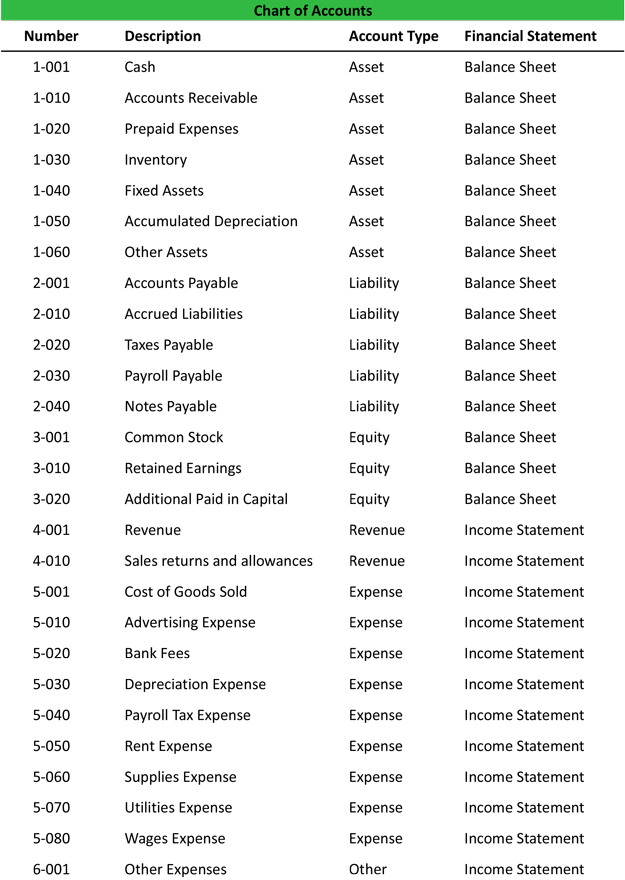
Size – Set up your chart to have enough accounts to record transactions properly, but don’t go over board. The more accounts you have, the more difficult it will be consolidate them into financial statements and reports. Also, it’s important to periodically look through the chart and consolidate duplicate accounts. If you don’t leave gaps in between each number, you won’t be able to add new accounts in the right order.
Understand Your Earnings
Add an account statement column to your COA to record which statement you’ll be using for each account, like cash flow, balance sheet, or income statement. For example, balance sheets are typically used for asset and liability accounts, while income statements are used for expense accounts. The standard chart of accounts usually contains two main categories – balance sheet accounts and income statement accounts – which are then further subdivided by account type. The COA is usually hierarchical, with accounts organized in categories and subcategories. These categories include assets, liabilities, equity, revenue, and expenses.

Do you already work with a financial advisor?
The company records each transaction (journal entry or accounting entry) in the general ledger account, and the general ledger totals create the trial balances. A chart of accounts isn’t required, but the valuable insights it provides can contribute to critical data-backed decision-making for your small business. Therefore, when crafting a chart of accounts, always consider the tax legislation, financial reporting standards, government regulations and other compliance requirements relevant in your circumstances. The accounting software then aggregates the information into an entity’s financial statements.
The balance sheet accounts
- A chart of accounts is a tool used to categorize and organize all the financial transactions in a company’s accounting system.
- He has experience as an editor for Investopedia and has worked with the likes of the Consumer Bankers Association and National Venture Capital Association.
- The main accounts within your COA help organize transactions into coherent groups that you can use to analyze your business’s financial position.
- The Chart of Accounts (COA) is a foundational tool in accounting, serving as the backbone of a company’s financial recordkeeping system.
- We believe everyone should be able to make financial decisions with confidence.
For example, bank fees and rent expenses might be account names you use. The subcategory account is usually represented by the second digit within the account code. For instance, let’s assume that the account code for a specific account is 109. Should the company liquidate its assets, for instance due to bankruptcy, the first priority will be the creditors.
By examining the liquidity of a company, one can better understand the organization’s ability to meet short-term financial obligations and its prospects for long-term growth and stability. The Chart of Accounts (COA) is a foundational component of a company’s financial record-keeping system. It serves as an organizational tool that lists all the accounts used to categorize transactions and keep track of the company’s financial history. A well-structured COA is essential for generating accurate financial reports, enabling the management to monitor financial performance and make informed decisions. That part of the accounting system which contains the balance sheet and income statement accounts used for recording transactions.
How can a chart of accounts be customized for different businesses?
The firm offers bookkeeping and accounting services for business and personal needs, as well as ERP consulting and audit assistance. A chart of accounts gives you a clear picture of how much money you owe a chart of accounts usually starts with in terms of short- and long-term debts. Your COA can help you determine how much of your monthly income you can afford to put toward your debts and help you develop longer-term debt repayment plans.
GAAP guidelines help ensure the uniformity and comparability of financial reporting, making it critical for accounting and auditing professionals to abide by these established principles. The accounts are identified with unique account numbers, and are usually grouped according to their financial statement classification. Take note, however, that the chart of accounts vary from company to company. The contents depend upon the needs and preferences of the company using it.
This section elaborates on the shareholders’ equity and retained earnings subsections. The main accounts within your COA help organize transactions into coherent groups that you can use to analyze your business’s financial position. In fact, some of the most important financial reports — the balance sheet and income statement — are generated based on data from the COA’s main accounts.